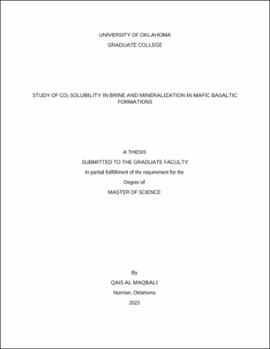| dc.description.abstract | A huge amount of CO2 emissions should be mitigated for environmental benefits and to reach net zero by 2050. One method to mitigate these emissions is permanent CO2 sequestration through mineralization. CO2 can be mineralized as carbonate minerals such as calcite and magnesite if injected into igneous formations rich in reactive minerals such as olivine, pyroxene and plagioclase. The dissolution of CO2 in brine is the first geochemical reaction in the pore space that leads to CO2 mineralization eventually. The objective of this study is to understand the dynamics and controlling parameters of CO2 dissolution in brine and mineralization in mafic basaltic formations.
This study uses a 3D carbon sequestration numerical model to simulate the geochemical reactions of injecting CO2 into a saline aquifer in a basaltic formation. The model includes three main geochemical reactions: CO2 dissolution in water, dissolution of formation minerals, and precipitation of carbonate minerals. The first reaction results in forming carbonic acid that reacts with the formation minerals: anorthite, wollastonite, pyroxene, and olivine, which results in releasing calcium and magnesium ions. The reaction between divalent cations and dissolved CO2 in brine results in precipitating carbonate minerals: magnesite and calcite. CO2 is injected into the formation for four years and simulated for 200 years. The dynamics of reservoir pressure and CO2 plume migration are studied as CO2 mineralizes. In addition, the rate of mineral dissolution and precipitation is analyzed as the initial conditions of the reservoir change, including brine salinity, temperature, and pH. In addition, the change in porosity and permeability is investigated during CO2 mineralization process.
The results show that 95% of the injected CO2 is mineralized within the first 7 years. After 200 years, 98% of injected CO2 is mineralized, 1.5% is dissolved in brine and 0.5% is residually trapped. Due to the mineralization of CO2 in the form of magnesite, and calcite, the porosity decreased by 5% maximum due to the extra cement in the pore space. Likewise, permeability decreases by 71%. The reservoir pressure increases during the injection but reduces by 15% after 200 years due to continuous CO2 mineralization. Lower reservoir temperature increases the amount of CO2 mineralized due to the higher CO2 solubility in water. Brine salinity has minimal effect on CO2 mineralization. The rate of CO2 mineralization is higher when the initial pH in a reservoir is lower.
The carbon storage numerical model built for this study considers the effect of the formation water chemistry and rocks mineralogy on the amount of CO2 sequestrated. In addition, it shows the advantage of targeting basaltic formations for CO2 storage compared to sedimentary formations. In addition, this study shows that CO2 can be stored permanently in the subsurface with no risk of leakage. | en_US |
